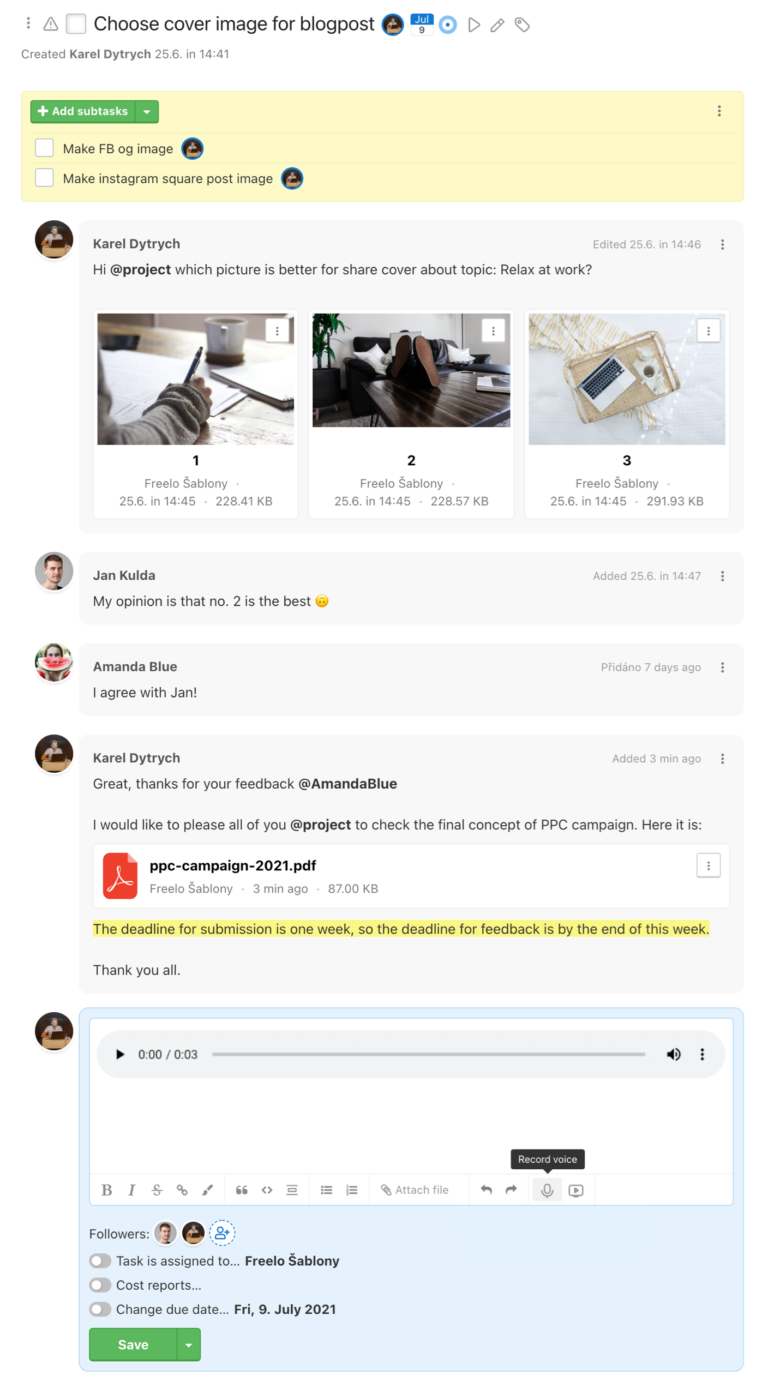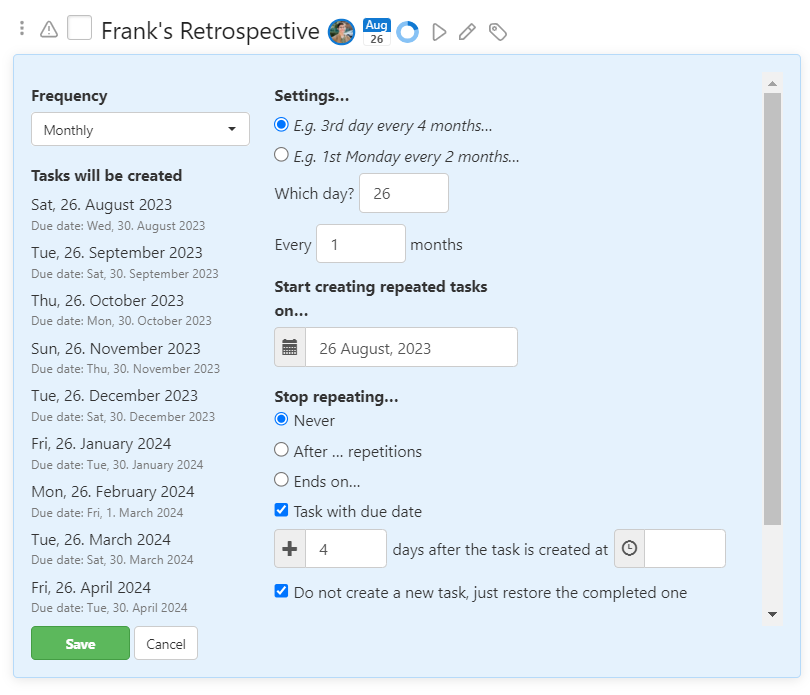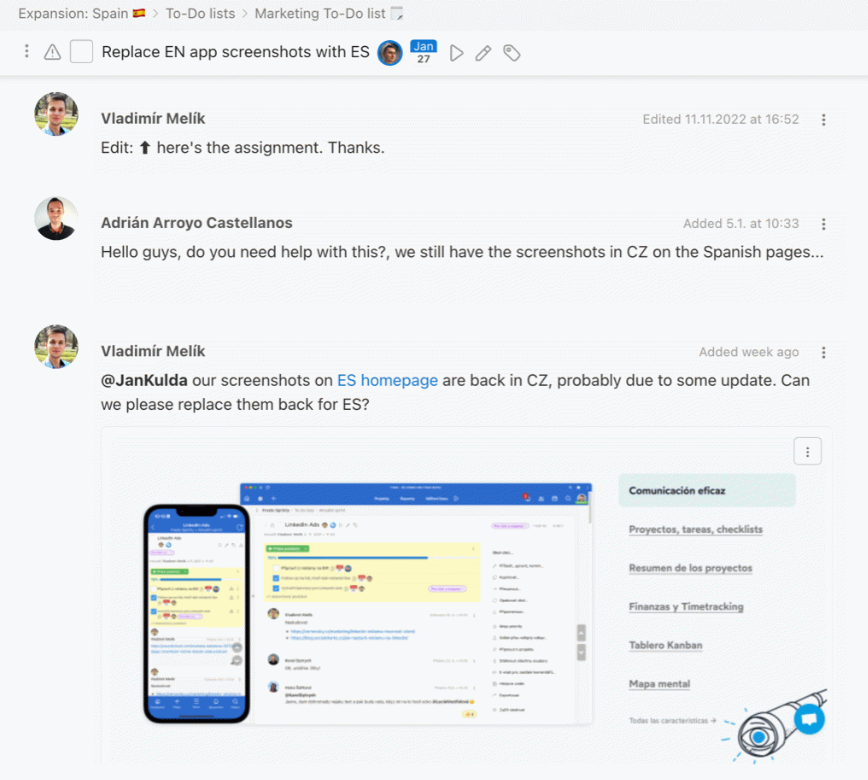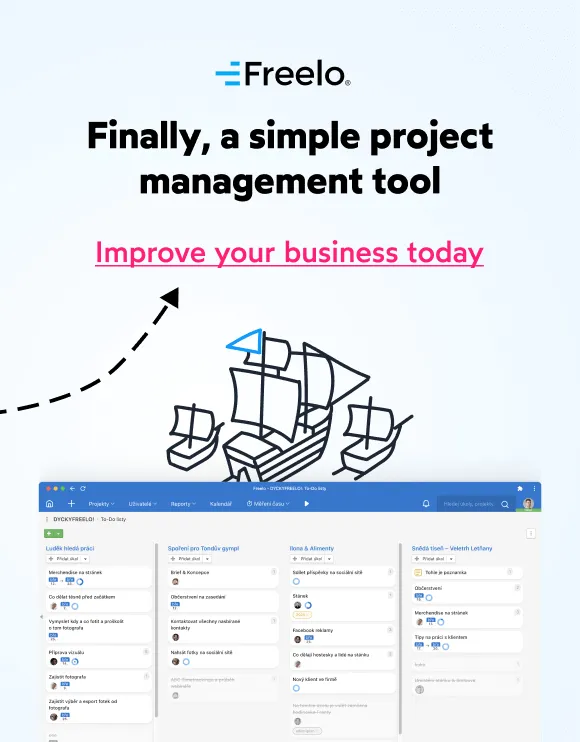Content
- The road to success is paved with good feedback
- Tip 1: Understand why to give feedback
- Tip 2: Learn when to give feedback most effectively
- Tip 3: Set aside enough time for feedback
- Tip 4: Prepare an outline for feedback
- Tip 5: Forget the sandwich method
- Tip 6: Bet on the OSCAR method
- Tip 7: Allow discussion
- Tip 8: How to give negative feedback
- Tip 9: How to praise employees
- Tip 10: It doesn’t end with the meeting
- Bonus tip: Training for better feedback and life
- Conclusion: How we give feedback at Freelo

Constructive Feedback: 10 Tips on How to React Well and Build Stronger Teams
 Freelo team
Freelo team

Content
- The road to success is paved with good feedback
- Tip 1: Understand why to give feedback
- Tip 2: Learn when to give feedback most effectively
- Tip 3: Set aside enough time for feedback
- Tip 4: Prepare an outline for feedback
- Tip 5: Forget the sandwich method
- Tip 6: Bet on the OSCAR method
- Tip 7: Allow discussion
- Tip 8: How to give negative feedback
- Tip 9: How to praise employees
- Tip 10: It doesn’t end with the meeting
- Bonus tip: Training for better feedback and life
- Conclusion: How we give feedback at Freelo
Performance interviews, activity feedback, 1:1 status, 121 meetings etc. Does your stomach get heavy and do you get goosebumps when it’s time to face these things? Unfortunately, many of us have grown up in a culture where evaluation is seen as something unpleasant, something you can’t comment on, and from which punishment is likely to result. Think back to those school report cards.
Employees deserve feedback
Although feedback is sometimes unpleasant, 75% of employees believe it is valuable. And 65% of employees said they would like to receive feedback more often.
The road to success is paved with good feedback
Feedback is a key aspect of personal and professional growth. It helps to identify weaknesses and build on strengths. Thus, to achieve better results on an individual and team level. Well-grasped feedback even builds trust and anchors communication.
Truly functional feedback requires some preparation. So don’t hesitate to read on for 10 proven tips on how to give constructive feedback.

Tip 1: Understand why to give feedback
Appreciation Motivates 🎉
69% of employees say they would work harder if they felt their efforts were more recognized. Companies that regularly provide feedback report a 14.9% lower employee turnover rate.
Especially in larger companies, promotion opportunities, training, bonuses and other (non)financial rewards are linked to the outcome of the evaluation interview, which is sometimes mistakenly considered the main purpose of feedback.
You’ve got to help
The real purpose of feedback is to review past activities and learn lessons. Constructive feedback from a supervisor helps a person to perform better, which will improve the overall results and ultimately contribute to the whole business.
Idea 💪
Choose people in your company who understand this and will approach feedback with an open mind. Whether it be while giving or receiving feedback.
During performance interview, you’ll potentially:
- Identify gaps in your company’s processes and fix them before they go wrong
- Create a safe space for new ideas
- Outline a plan for the employee’s personal and career development
- Strengthen the relationship between managers and their subordinates
Tip 2: Learn when to give feedback most effectively
Who knows the answer to the question: „How often do I give feedback?“ gets a golden maze.
Chances are high, because there are more than one right answer. 😉
Did you know?
One in five employees are unsure whether their manager will regularly provide constructive feedback.
Give feedback regularly
Jindra Hraško Brousková, HR expert, recommends giving feedback every week. According to coach and trainer Zbyněk Rozbořil, once a month is enough. However, all experts agree that feedback should take place at least once every quarter.
New team members should expect more frequent feedback. After a few weeks or months, you may be able to slow down.
Whatever frequency you choose, let your subordinates know what frequency they are on.
Idea 💪
In addition to fixed calendar meetings, you can introduce an „open door“ time during which an employee can ask for feedback, coaching or advice.

Don’t delay with feedback
Feedback has a greater effect the shorter the time that has elapsed since the situation was commented on. The next time your subordinate presents, goes to a meeting or turns in a report, be sure to give them short feedback, ideally as soon as you are in private. You can come back to this in greater detail later in the scheduled meeting.
Did you know?
63% of Generation Z said they want to hear more immediate and constructive feedback on performance throughout the year.
All generations hear instant feedback, but the youngest workers even more so.
At Freelo, we give feedback on specific tasks immediately, clearly and transparently. It is visible to everyone involved. The correct delivery of the message, including tone of voice and facial expression, is facilitated by the voice and/or screen recording function.

Inspiration from Freelo: 1-to-1 retrospective
👩🏻💻👩💼
Once a month, each sailor reviews the past period with his captain. We call it a „van-tu-van retro.“ In addition, we have a team retrospective (quarterly) and a Lighthouse (monthly) where we break down what’s new in the product and what’s alive on deck. We reflect on what went (wrong) and share inspiration.

Tip 3: Set aside enough time for feedback
Block at least 2 hours on your calendar for one quarterly or annual review interview. The interview itself will take about an hour. Allow another 30 minutes as a buffer so that you can complete everything in peace. That’s a total of an hour and a half. Don’t schedule any more appointments for the next half hour to give you time to absorb all the emotions. Especially if you expect the feedback to not go completely smoothly.
If you use a monthly or even weekly feedback frequency, you can probably fit in 30-45 min.
Idea 💪
Take notes during the interview and edit and save them as soon as you’re done.
Do not interrupt scheduled feedback
You have a busy calendar, you’re not keeping up with deadlines, you haven’t even had lunch yet, and your calendar is blocked by 2 hours for feedback to a subordinate. Your hand itches to cancel. But resist. Although it doesn’t seem like it, feedback is a priority. Only cancel meetings for very serious reasons, especially if it’s an annual review.
Address topics one at a time
Always try to give feedback on one topic at a time and don’t combine them together. This makes it easier to interrupt the meeting if necessary and finish it another time.
Tip 4: Prepare an outline for feedback
For 1-to-1 conversations, take extra care not to be disturbed. The person being evaluated must feel safe and, if possible, comfortable.
Idea 💪
If you expect the feedbacks to be well received, you can have the conversation outside the office and combine it with lunch.
Sample structure for a performance interview
- Greet the interviewee.
- Give him time to settle in.
- Swap a few sentences on a lighter topic like the weather or food to ease the tension.
- Move on to the actual evaluation from your side.
- Give the interviewee space to comment on your evaluation.
- Ask for feedback on your cooperation, your leadership, and your managerial approach.
- Agree on the following steps.
- Say goodbye and, if the situation allows, lighten the atmosphere again with small talk.
What questions to ask in the employee performance interview
The exact wording of the questions will depend on the individual employee, their position and performance. To get started, use the following examples:
- How would you evaluate your results?
- What would help you achieve better results?
- How satisfied are you with your results/workload/team?
- In what areas would you like to be trained?
- Where do you want to advance to?
Tip 5: Forget the sandwich method
The sandwich method, where you hide unpleasant criticism between two compliments like filling for bread, is still very popular among managers. But it can go badly wrong and one of two things happens.
1. The employee leaves with the mistaken impression that all is well.
What do people remember most? The beginning and the end. What’s at the beginning and the end? Praise. And a misunderstanding of feedbacks.
2. The employee leaves unnecessarily crushed.
The method is already very well known, so it may result in the opposite of the first case. The employee expects criticism after a positive start. Therefore, they do not focus on the praise and perceive it as insincere.

Tip 6: Bet on the OSCAR method
The OSCAR method takes you through the feedback step by step.
Situation-behaviour-fall
If you’ve heard of the situation- behaviour-fall method, it’s practically the same thing. Only OSCAR goes into more detail.
O: Observation: start by describing the situation from your point of view. Use the first person. Talk only about yourself. No, „Franta said.“ or „Everyone is complaining.“
„I notice you look at your phone during the day.“
S: Specific: Don’t generalize. Don’t say sentences like, „You’re always late.“ and „Everything is a problem.“
„Yesterday you looked at your phone 10 times a day for five minutes.“
C: Consequence: talk about consequences and how they affect others.
„That’s why you didn’t notice the front desk calling you because the client arrived early for the appointment.
A: Alternative: suggest other ways to solve
„You could look at your phone outside of work or at lunch.“
R: Result: What are the positive outcomes of the behavioral change? „It will make you more aware of your surroundings so you can act more pro-client.“
See what the employee says. Maybe he’s in a long-distance relationship and there’s a big time gap between him and his other half. It might help to push back his hours by half an hour so he can call his girlfriend. Or he has a cool app on his phone that he uses legitimately for work- related tasks. Or he’s addicted to TikTok. Who knows… Either way, it’d be great if you could find a solution together.
Feedforward? 🤓
As this type of evaluation is mainly future-oriented, it is becoming known as „feedforward“ instead of „feedback“.

Tip 7: Allow discussion
It’s been said before, but I’d rather say it again. Part of a successful feedback is discussion. Allow a subordinate to comment on your review. You might find out why they see the situation differently. Especially in multicultural teams, you have to take extra care to understand the other person’s mindset.
Idea 💪
Not all people are the same. They don’t think alike. And they don’t act the same. Respect the differences. You won’t go wrong if you get to know employees better in terms of their personalities and motivators, for example through personality tests.
Is the feedback a gift?
I’m sure you’ve come across this statement before. But have you understood it correctly? This metaphor is meant to say that the person in question gives feedback with good intentions and with the aim of helping the recipient. And that it is appropriate to thank the feedback. However, it is not meant that you should thank the feedback and not comment on it in any way, as one of the managers in the training understood. On the contrary, constructive discussion is in order.
360° feedback
In most cases, the feedback is supposed to take place between four eyes. The exception is when a manager or subordinate expects a complicated process and prefers to invite a third impartial person. However, there is also so-called 360° feedback, where several people comment on the person being evaluated at the same time.
Who’s judging?
A total of 4-8 people.
- Self-rated people,
- Supervisors,
- Subordinates,
- Colleagues in the same or similar position within the team,
- Collaborating colleagues from other teams,
- Optional clients/customers/suppliers and more.
When to use instead of the classic one-on-one?
- When you’re considering a promotion or a raise.
- When downsizing is a threat.
- When you need to compare employees in the same or similar job in the same grad who do not have the same calibration is also used for this purpose.
- When the ratee doesn’t trust the supervisor’s feedback.
How does it work?
Respondents receive an anonymous questionnaire in which they answer questions about the person being evaluated. Today, there are a number of tools that allow the questionnaire to be administered online and greatly facilitate data processing and evaluation.

Tip 8: How to give negative feedback
All of the previous tips apply to both positive and negative feedback. In the case of negative feedback, however, there is a risk of poorer acceptance by the employee.
As a manager, be prepared for strong emotions of a subordinate so that you are not caught off guard by them.
- When a subordinate is crying, not talking, sad or puzzled, let him/her experience the emotion, keep silent, at most emphasize that you are trying to help him/her. Offer to „work it out“ or step away and come back. If he or she is in a very strong emotional state, interrupt the meeting and continue another time.
- When a subordinate goes into aggression, follow a similar procedure as in the previous case. Think of your own safety. Leave the room without a word rather than be the target of a physical attack.
- When the subordinate does not admit any mistake and negates everything, explain again the reason for the feedbacks. You can also reschedule the meeting and continue when the emotions.
In cases where you expect a bad reaction, it is possible to make an exception to the four-eyes rule and invite a third person to the interview, ideally an impartial person, e.g. a representative of HR, a trade union, etc. Alternatively, include 360° feedback – see previous point.
Tip 9: How to praise employees
Praise and feedback are not the same thing. Yet both are important for happy and motivated employees.
Praise: It is more general than feedback and is focused on the outcome. It is always positive and does not dilute with negatives. Praise by name and for specific things.
For example, „I appreciate that you were able to quickly get key information from the technical department even during the holiday season.“
Feedback: it is focused on a specific thing and its impact. It is forward-looking and the aim is to learn. It can be positive or negative, and is usually balanced.
For example, „You managed to finish the project okay, good job. I noticed you struggled a bit with time management. Let’s take a look at what to do about it. Here are some suggestions on how to change that.“
Praising in private and in front of the „embarked unit“
While you should always give feedback between four eyes, with praise it is not so clear- cut. When you praise in private, you can afford to go into more detail. Follow-up questions like, „How did you do? and „How did you think of that?“ because they show a genuine interest in the employee.
However, it is also useful to publish the praise. It makes the person praised happy and inspires others. You can use internal communication methods such as a bulletin board, company magazine, etc. or do it at a team meeting. If you set up a system of individual and team meetings for feedbacks, you won’t have to hesitate where to include the praise. At Freelo, quarterly team retrospectives or the once-a-month Lighthouse are used for this. We also associate Freelo’s chatbot Bird in Slack with praise.
Be careful not to praise just someone and forget about others. Keep an eye on what you praise employees for. If you can’t think of anything, try to find out more about the person’s work. If you’re still stuck, there’s a deeper problem.
Tip 10: It doesn’t end with the meeting
When the meeting is over:
- Create a write-up that includes an evaluation of the goals (including interim) and setting goals for the next You may have a template for this in your company.
- Both of you confirm that you agree with the conclusions, e.g. by signing, entering into the system, etc.
- Schedule the next meeting.

Bonus tip: Training for better feedback and life
There are a number of feedback training courses and I’m sure you’ve attended a few yourself. That’s why we suggest something a bit out of the box. Something that can be used in both professional and private life, and therefore can also serve as an interesting benefit.
Non-violent communication
Non-violent communication minimizes conflict and improves understanding between people through empathy, authenticity and sharing of needs. To do this, it uses similar tools to the OSCAR method – for example, first-person commenting and finding solutions together. The goal is that no one comes out of a conflict a loser.
It is a comprehensive concept that can be used at work, at home and in international politics.
Self-Experience Training
This is a more challenging issue as it takes 5 years and requires a large financial and time commitment. It is mandatory for all psychotherapists. But any college educated person can take the self-experience training if interested.
Fake it till you make it
During feedbacks, you should be calm, open, listen and, above all, look nice. But what if you have a resting bitch face? If you want to be a great boss, you’ll have to put on an approachable face.
Conclusion: How we give feedback at Freelo
One of the reasons why Freelo was created was the need to give quick, unambiguous and constructive feedback on tasks. It is easy for a solver to ask for feedback in a comment and just as easy for a colleague to give it. In this case, those who are working on the task can also see it, so they can also comment. Alternatively, they can learn from the feedback as well.
This makes onboarding newcomers faster and more enjoyable. Everything is done asynchronously and quietly remotely.

You can read how important an important part of healthy working relationships is honest individual and team feedback in the article about company culture.
 Freelo team
Freelo team





